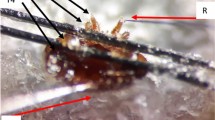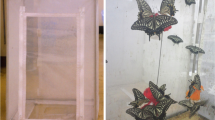Abstract
Electroantennograms in two populations ofIps pini (Idaho and New York) were very similar, even though previous work documented behavioral specificity and revealed that the populations produce different ratios of the enantiomers of the aggregating pheromone ipsdienol. The insect- and host-produced compounds tested evoked characteristic response curves in both populations. EAG amplitude was highest to ipsdienol and the aggregation inhibitor ipsenol. Among the other compounds tested, responses were generally higher to the beetle-produced odorants (linalool, verbenone,trans-verbenol) than to host terpenes (1-octanol, α-pinene). The antennal club and its sensory receptors are described and illustrated by scanning electron micrographs.
Similar content being viewed by others
References
Birch, M.C.,andWood, D.L. 1975. Mutual inhibition of the attractant pheromone response of two species ofIps.J. Chem. Ecol. 1:101–113.
Boeckh, J., Kaissling, K.-E., andSchneider, D. 1965. Insect olfactory receptors.Cold Spring Harbor Symp. Quant. Biol. 30:263–280.
Borden, J.H., andWood, D.L. 1966. The antennal receptors and olfactory response ofIps confusus (Coleoptera: Scolytidae) to male sex attractant in the laboratory.Ann. Entomol. Soc. Am. 59:253–261.
Borden, J.H., Chong, L., McLean, J.A., Slessor, K.N., andMori, K. 1976.Gnathotrichus sulcatus: Synergistic response to enantiomers of the aggregation pheromone sulcatol.Science 192:884–896.
Dickens, J.C., andPayne, T.L. 1977. Bark beetle olfaction: Pheromone receptor system inDendroctonus frontalis.J. Insect Physiol. 23:481–489.
Hedden, R., Vité, J.P., andMori, K. 1976. Synergistic effect of a pheromone and a kairomone on host selection and colonization byIps avulsus.Nature (London) 261:696–697.
Hopping, G.R. 1964. The North American species in groups IV and V ofIps De Geer (Coleoptera: Scolytidae).Can. Entomol. 96:970–978.
Kafka, W.A., Oloff, G., Schneider, D., andVareschi, E. 1973. Olfactory discrimination of two enantiomers of 4-methyl-hexanoic acid by migratory locust and honeybee.J. Comp. Physiol. 87:277–284.
Lanier, G.N. 1972. Biosystematics of the genusIps (Coleoptera: Scolytidae) in North America. Hopping's groups IV and X.Can. Entomol. 104:361–388.
Lanier, G.N., Birch, M.C., Schmitz, R.F., andFurniss, M.M. 1972. Pheromones ofIpspini (Coleoptera: Scolytidae): Variation in response among three populations.Can. Entomol. 104:1917–1923.
Mustaparta, H., Angst, M.E., andLanier, G.N. 1979. Specialization of olfactory cells to insect- and host-produced volatiles in the bark beetleIps pini (Say).J. Chem. Ecol. 5:109–123.
Payne, T.L. 1970. Electrophysiological investigations on response to pheromones in bark beetles.Contrib. Boyce Thompson Inst. 24:275–282.
Payne, T.L. 1975. Bark beetle olfaction III. Antennal olfactory responsiveness ofDendroctonus frontalis Zimmerman andD. brevicomis Le Conte (Coleoptera: Scolytidae) to aggregation pheromones and host tree terpene hydrocarbons.J. Chem. Ecol. 1:233–242.
Payne, T.L., Shorey, H.H., andGaston, L.K. 1970. Sex pheromones of noctuid moths: factors influencing antennal responsiveness in males ofTrichoplusia ni.J. Insect Physiol. 16:1043–1055.
Piston, J.J., andLanier, G.N. 1974. Pheromones ofIps pini (Coleoptera: Scolytidae): Relative attractiveness of interpopulational hybrids and interpopulational response to males boring in two host species.Can. Entomol. 106:247–251.
Priesner, E. 1968. Die interspezifischen Wirkungen der Sexuallockstoffe der Saturniidae (Lepidoptera).A. Bergl. Physiol. 61:263–297.
Riley, R.G., Silverstein, R.M., andMoser, J.C. 1974. Biological responses ofAtta texana to its alarm pheromone and the enantiomer of the pheromone.Science 183:760–762.
Roelofs, W.L., andComeau, A. 1971. Sex pheromone perception: Electroantennogram responses of the red-banded leafroller moth.J. Insect Physiol. 17:1969–1982.
Schneider, D. 1957. Elektrophysiologische Untersuchungen von Chemo- und Mechanorezeptoren der Antenne des SeidenspinnersBombyx mori. L. Z. Vergl. Physiol. 40:8–41.
Schneider, D. 1964. Insect antennae.Annu. Rev. Entomol. 9:103–122.
Stewart, T.E. 1975. Determination of enantiomeric composition of several insect pheromone components. Master's Thesis, SUNY College of Environmental Science and Forestry, Syracuse, New York.
Vité, J.P., Hedden, R., andMori, K. 1976.Ips grandicollis: Field response to the optically pure pheromone.Naturwissenschaften 63:43–44.
Wood, D.L., Browne, L.E., Ewing, B., Lindahl, K., Bedard, W.D., Tilden, P.E., Mori, K., Pitman, G.B., andHughes, P.R. 1976. Western pine beetle: Specificity among enantiomers of male and female components of an attractant pheromone.Science 192:896–898.
Yamada, M., Saito, T., Katagiri, K., Iwaki, S., andMarumo, S. 1976. Electroantennogram and behavioral responses of the gypsy moth to enantiomers of disparlure and itstrans analogues.J Insect Physiol. 22:755–761.
Young, J.C., Brownlee, R.G., Rodin, J.O., Hilderbrand, D.N., Silverstein, R.M., Wood, D.L., Birch, M.C., andBrowne, L.E. 1973. Identification of linalool produced by two species of bark beetles of the genusIps.J. Insect Physiol. 19:1615–1622.
Author information
Authors and Affiliations
Additional information
From a thesis presented in partial fulfillment of the degree Master of Science. Department of Environmental and Forest Biology, SUNY College of Environmental Science and Forestry, Syracuse, New York 13210
Rights and permissions
About this article
Cite this article
Angst, M.E., Lanier, G.N. Electroantennogram responses of two populations ofIps pini (Coleoptera: Scolytidae) to insect-produced and host tree compounds. J Chem Ecol 5, 131–140 (1979). https://doi.org/10.1007/BF00987694
Received:
Revised:
Issue Date:
DOI: https://doi.org/10.1007/BF00987694




